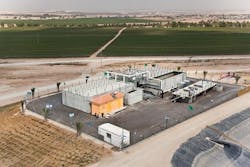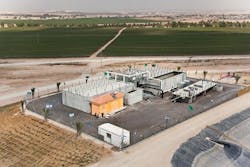The Oconomowoc, WI, Wastewater Treatment Facility replace its traveling bridge sand filters with a new Hydrotech Discfilter system from Kruger. The system was designed to meet 10 States Standards and consists of woven cloth filter elements installed on multiple discs. Using an inside-out flow pattern, the compact system increased treatment capacity while fitting within the existing filter basins.
By Mark Stewart
The Oconomowoc, WI, Wastewater Treatment Facility (WWTF) is located in Waukesha County. The original plant dated back to 1935. In 1975 the facility relocated and upgraded from a trickling filter biological treatment system to activated sludge. Fine bubble aeration was installed in the late 1980s for further improvement. Additional projects for sludge processing, de-chlorination, filtrate storage/handling, and fine screening were completed between 1990 and 2005.
The current wastewater process train consists of screening, pumping, grit removal, primary settling, activated sludge, secondary settling, tertiary filtration, disinfection, and oxygen uptake prior to discharge to the Oconomowoc River. The facility also includes air floatation thickening, anaerobic digestion, gravity thickening, and agricultural land application for sludge treatment.
The WWTF provides treatment for residential, commercial, and industrial wastewater generated in Oconomowoc as well as several other neighboring sanitary districts. The plant is designed for an average day flow of 4 mgd and a peak flow of 9 mgd. The facility averages approximately 2.5 mgd and has experienced peak flow rates up to 11.9 mgd. The facility must meet effluent limits of 10 mg/L of total suspended solids (TSS) prior to discharge.
Shortly after the most recent upgrades in 2005, the facility realized the need to repair or replace the existing shallow bed traveling bridge sand filters. The sand filters had reached the end of their lifespan and needed significant maintenance improvements to continue to be viable. In addition, the facility needed to upgrade the filtration capacity from 9 mgd to 12 mgd to allow treatment of peak capacities. The City of Oconomowoc worked with engineering firm Ruekert/Mielke to evaluate various technologies to replace the existing filters.
Together with Ruekert/Mielke, the city determined in 2007 that Kruger’s Hydrotech Discfilter system would be the ideal replacement for the existing filters. Four of the model HSF2214-1F filter units with an integrated PLC control system were provided by Kruger. The system was designed to meet 10 States Standards by maintaining loading rates ≤ 5 gpm/sf during peak flow conditions with one of the units out of service.
The system consists of woven cloth filter elements installed on multiple discs, and uses an inside-out flow pattern. Water to be treated flows by gravity into the filter segments from the center drum. Once solids have accumulated on the inside of the media, the discs are cleaned by a counter-current backwash system.
As a result of the compact footprint and low operating headloss of the Hydrotech units, the filters could be located within the existing filter basins while providing the increased capacity to allow treatment up to 12 mgd. In addition, the city anticipated reductions in operation and maintenance costs as a result of the lower backwash volumes and reduced equipment repair costs associated with the system.
The city installed the new filtration system in a phased approach. First, they removed half of the existing sand filters from service in order to clean out those filter cells and install two of the new filters. They were installed in one side of the existing filter building and were commissioned in November 2008. Once these units were online, the city decommissioned the rest of the existing filters and the basins were prepared for the remaining disc filters. The project was completed in March 2009 when the final two filters were commissioned.
The facility has consistently met permit limits since completing the filter project. The influent to the filter system typically averages approximately 10 to 15 mg/L of TSS with peaks up to 35 to 40 mg/L. The new filters produce effluent with average TSS < 3 mg/L.
While the sand filters typically averaged approximately 60% removal of TSS, data collected by the facility after disc filter startup has demonstrated the system’s ability to routinely achieve 80% to 90% removal of TSS. Additionally, the backwash volumes have been reduced significantly and filtration system maintenance has dropped to a minimum.
The Oconomowoc WWTF staff enjoys the straight-forward design that has simplified routine inspection and maintenance. Another benefit of the system is the added flexibility that having four units provides compared to only two units with the previous sand filters. This allows the facility to maintain, inspect, and repair the filter equipment without such a large reduction in capacity when one unit is removed from service.
Finally, the Operations Manager for the WWTF, Tom Steinbach, has seen another benefit that was not anticipated.
“The old filters had a large water surface area that was exposed inside the filter building, resulting in high humidity. The enclosed Discfilter design has removed the exposed water surface area and dramatically reduced the humidity in the building, resulting in an unexpected reduction in our energy cost for heating,” he said.
WW
About the Author: Mark Stewart is the Product Manager for Hydrotech Filtration at Kruger. He has worked in the field of wastewater treatment since 1997, with experience in engineering, operations, project management, and product management.
More WaterWorld Current Issue Articles
More WaterWorld Archives Issue Articles




